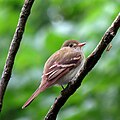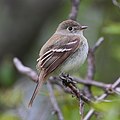Superregnum: Eukaryota
Regnum: Animalia
Subregnum: Eumetazoa
Cladus: Bilateria
Cladus: Nephrozoa
Superphylum: Deuterostomia
Phylum: Chordata
Cladus: Craniata
Subphylum: Vertebrata
Infraphylum: Gnathostomata
Superclassis: Tetrapoda
Cladus: Reptiliomorpha
Cladus: Amniota
Classis: Reptilia
Cladus: Eureptilia
Cladus: Romeriida
Subclassis: Diapsida
Cladus: Sauria
Infraclassis: Archosauromorpha
Cladus: Crurotarsi
Divisio: Archosauria
Subsectio: Ornithodira
Subtaxon: Dinosauromorpha
Cladus: Dinosauria
Ordo: Saurischia
Cladus: Theropoda
Cladus: Neotheropoda
Infraclassis: Aves
Ordo: Passeriformes
Subordo: Tyranni
Infraordo: Tyrannides
Parvordo: Tyrannida
Familia: Tyrannidae
Genus: Empidonax
Species: E. affinis – E. albigularis – E. alnorum – E. atriceps – E. difficilis – E. flavescens – E. flaviventris – E. fulvifrons – E. hammondii – E. minimus – E. oberholseri – E. occidentalis – E. traillii – E. virescens – E. wrightii
Name
Empidonax Cabanis, 1855
Typus: Platyrhynchos virescens Vieillot, 1818 = Empidonax virescens
References
Cabanis, J. 1855. In: Dr. J.Gundlach's Beiträge zur Ornithologie Cuba's. Nach Mittheilungen des Reisenden an Hr. Bez.– Dir. Sezekorn in Cassel; von Letzterem zusammengestellt. Mit Zusätzen und Anmerkungen geordnet vom Herausgeber. Journal für Ornithologie 3(18): 465–480. DOI: 10.1007/bf02009761 BHLReference page. Original description p. 480 BHL
The genus Empidonax is a group of small insect-eating passerine birds in the tyrant flycatcher family, the Tyrannidae. The genus name Empidonax is from Ancient Greek empis, "gnat", and anax, "master".[1]
Most of these birds are very similar in plumage: olive on the upper parts with light underparts, eye rings and wing bars. In the nesting season they may be distinguished by range, habitat and call; in other situations, particularly on migration and in winter, it may not be possible to be sure of specific identification.
Empidonax flycatchers often flick their wings and tails rapidly.
Euler's flycatcher, Lathrotriccus euleri and gray-breasted flycatcher, Lathrotriccus griseipectus were formerly placed in Empidonax, but differ anatomically and biochemically and are now placed in the genus Lathrotriccus.
Species
The genus contains 15 species:[2]
| Image | Scientific name | Common Name | Distribution |
|---|---|---|---|
 |
Empidonax flaviventris | Yellow-bellied flycatcher | North America, Mexico and Central America |
 |
Empidonax virescens | Acadian flycatcher | eastern United States and southwestern Ontario, eastern Mexico and the Caribbean to southern Central America and the very northwest of South America in Colombia, western Venezuela, and Ecuador |
 |
Empidonax alnorum | Alder flycatcher | Canada and Alaska, descending to a southernmost point in the northeastern United States |
 |
Empidonax traillii | Willow flycatcher | United States and southern Canada |
 |
Empidonax albigularis | White-throated flycatcher | Belize, Costa Rica, El Salvador, Guatemala, Honduras, Mexico, Nicaragua, and Panama. |
 |
Empidonax minimus | Least flycatcher | eastern North America |
 |
Empidonax hammondii | Hammond's flycatcher | western United States, Alaska and Canada |
 |
Empidonax wrightii | American grey flycatcher | western North America, especially the Great Basin. |
 |
Empidonax oberholseri | American dusky flycatcher | southern Arizona and Mexico |
 |
Empidonax affinis | Pine flycatcher | Mexico and southwestern Guatemala. |
 |
Empidonax difficilis | Pacific-slope flycatcher | western North America, including the Pacific Ocean and the southern Gulf of California |
 |
Empidonax occidentalis | Cordilleran flycatcher | California to Alaska |
 |
Empidonax flavescens | Yellowish flycatcher | southeastern Mexico south to western Panama. |
 |
Empidonax fulvifrons | Buff-breasted flycatcher | United States through Mexico to southern Honduras. |
 Costa Rica MG 7063 (26603418092).jpg" decoding="async" srcset="//upload.wikimedia.org/wikipedia/commons/thumb/0/01/Black-capped_Flycatcher_-_Central_Highlands_-_Costa_Rica_MG_7063_%2826603418092%29.jpg/180px-Black-capped_Flycatcher_-_Central_Highlands_-_Costa_Rica_MG_7063_%2826603418092%29.jpg 1.5x, //upload.wikimedia.org/wikipedia/commons/thumb/0/01/Black-capped_Flycatcher_-_Central_Highlands_-_Costa_Rica_MG_7063_%2826603418092%29.jpg/240px-Black-capped_Flycatcher_-_Central_Highlands_-_Costa_Rica_MG_7063_%2826603418092%29.jpg 2x" data-file-width="760" data-file-height="1140" height="180" width="120" /> Costa Rica MG 7063 (26603418092).jpg" decoding="async" srcset="//upload.wikimedia.org/wikipedia/commons/thumb/0/01/Black-capped_Flycatcher_-_Central_Highlands_-_Costa_Rica_MG_7063_%2826603418092%29.jpg/180px-Black-capped_Flycatcher_-_Central_Highlands_-_Costa_Rica_MG_7063_%2826603418092%29.jpg 1.5x, //upload.wikimedia.org/wikipedia/commons/thumb/0/01/Black-capped_Flycatcher_-_Central_Highlands_-_Costa_Rica_MG_7063_%2826603418092%29.jpg/240px-Black-capped_Flycatcher_-_Central_Highlands_-_Costa_Rica_MG_7063_%2826603418092%29.jpg 2x" data-file-width="760" data-file-height="1140" height="180" width="120" /> |
Empidonax atriceps | Black-capped flycatcher | Costa Rica and western Panama. |
References
Jobling, James A (2010). The Helm Dictionary of Scientific Bird Names. London: Christopher Helm. p. 146. ISBN 978-1-4081-2501-4.
Gill, Frank; Donsker, David, eds. (2019). "Tyrant flycatchers". World Bird List Version 9.2. International Ornithologists' Union. Retrieved 29 June 2019.
Retrieved from "http://en.wikipedia.org/"
All text is available under the terms of the GNU Free Documentation License

